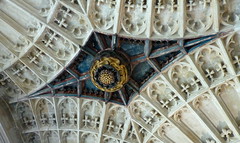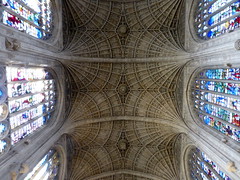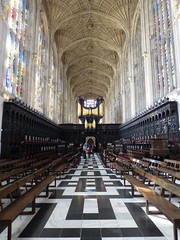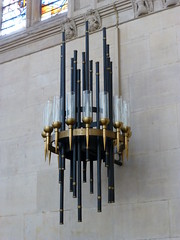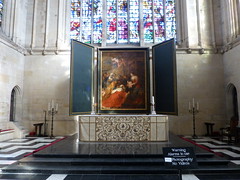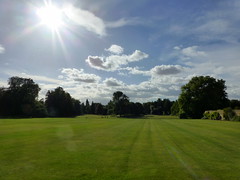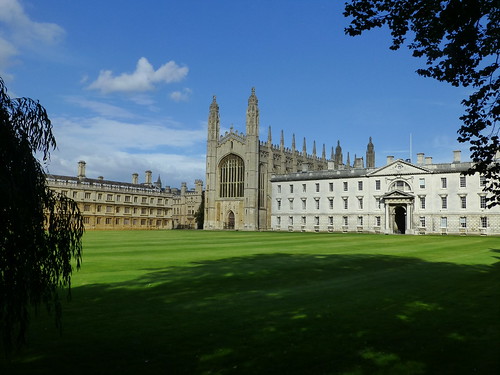The Wonder of Dogs
The last episode of the dogs series was about dog personalities & dogs as pets. It made the point that although breeds have tendencies towards personality traits each dog is an individual. And that the first few weeks/months of a dog’s life are critical for enabling it to bond with people. They also talked about how it’s not that particular breeds are particularly prone to attacking people, but more the differences in what the dog does if it is badly trained/badly behaved – a labrador will tend to bite hands & arms and to bite & release. That’s much more survivable than the way a pit bull will go for face & neck and bite & hold on. So pit bulls have a reputation for being vicious when the average pit bull isn’t – the badly trained ones cause more problems tho.
They talked about the top 10 breeds kept as pets in the UK, and what about dogs makes them such good pets. Which basically boils down to the fact that we’ve bred them into forming close bonds with their owners. They showed us the classic owner-leaves-the-room experiments where the dog is visibly concerned until their person comes back. There was also demonstration of the fact that dogs generally want to comfort people – a researcher who hadn’t met the dogs before was faking crying, and each dog they tested went over to her to try & lick her face & cheer her up.
It was a good series, although I think it’s a little unfair that dogs got a three part series & cats got a programme & a half on Horizon for a similar thing! 😉
David Attenborough’s Rise of the Animals: Triumph of the Vertebrates
The second & last part of the recent David Attenborough series about evolution of the vertebrates concentrated on the mammals. As with the first episode I have reservations about the language used – too much of a sense of purpose & direction to what’s a much more random process than was implied. However it was still a neat programme – I liked the mix of CGI and fossils. In particular the shrew-like early mammal skull that they showed turning into a little skeleton walking around on David Attenborough’s fingers. This episode had fewer surprises for me than the previous one – it name checked all the critical mammalian features (fur, warm-blooded, live young, milk) and took in the monotremes & marsupials on the way to placental mammals and eventually apes & humans.
Ancient Greece: The Greatest Show on Earth
The second part of Michael Scott’s series about Greek drama & Greek history talk about how when democracy & Athenian supremacy wobbled drama managed to broaden its appeal & go from strength to strength. One of the changes was the rise to prominence of actors, and the restaging of old plays – when drama first started it was the playwright who was the only named individual involved (in terms of records that come down to us) and the plays performed were the new ones for the festival that year. But over the 4th Century BC there begin to be awards for actors at the festival, and often the old classics are staged after the new plays. And this is really why we have copies of the surviving plays – the old classics were copied out many times, and so managed to survive intact.
Comedy also shifted in form – at the start of the period they were bawdy and pointedly aimed at current personages & situations whilst being nominally about myths. Whereas by the end of the period the bawdiness was toned down (no more strap on phalluses, as Scott put it) and the tone had shifted to being about ordinary people and stock character types. Much closer to modern comedy, in fact. This was part of how drama’s appeal was broadening as Athens and its democracy ceased to be the centre of the Greek world. Drama was becoming entertainment rather than a part of the political process. And that increased popularity across the Greek world meant that when the Macedonians (under first Philip & then Alexander) were taking over much of the known world they also spread theatres and drama throughout the empire.
The next part promises to be about the Romans, and their reaction to/inheritance of Greek drama.
John Sergeant on Tracks of Empire
This is a two part series about the railways in India. The premise is that John Sergeant travels the length and breadth of India on the train, and talks about the history both of the railroad and of India during and post British Empire. In this episode he travelled from Calcutta west & north-west towards the Pakistan border. Along the way he talked about the railway towns that grew up to house the men who worked on the railway. He met some of the modern day railworkers, who are devoted to the job of keeping the network running – regarding it as a vital service to their country. He also talked about modern disruption to the rail network by violent protests (blowing up bits of track etc) and about past violence. This included visiting a house besieged during the “Indian Mutiny”. He’s more pro-Empire than is currently fashionable, and this segment made me wince a bit because he was playing up the clueless Englishman abroad thing with “but don’t you think the British soldiers were heroic” while talking to a group of Indians who regarded the leader of the siege as the true hero – the start of the fight for independence. And I felt it came across as a bit patronising, particularly in the context of “paternalistic” attitudes from the British Empire back in its heyday.
The programme finished at the India/Pakistan border. He talked to some people who’d lived through the appalling violence after the partition of India post-independence, which was particularly disturbing to watch. And the next & last segment was filmed at the border itself – the two armies in their fancy uniforms prancing around like something out of a Monty Python sketch, while citizens of each country chanted encouragement like they were at a football match. For all it was funny to see, it was sobering too – keeping the tribalism going and the wounds open.
Stories from the Dark Earth: Meet the Ancestors Revisited
The premise of this series is Julian Richards revisiting the finds from some archaeological digs he’d been part of over a decade ago – ones that were filmed as part of a series called Meet the Ancestors. The episodes are interspersing the original footage with new work that’s been done on the finds. The first episode was about two Roman burials dating from the 4th Century AD. He’d been discovered in a lead coffin, and was buried in a way that showed he had (or his family had) pagan beliefs. More recent analysis of his teeth has shown that he was definitely a local man. A survey off all the Roman era bodies that’ve been found in Winchester showed that about 30% of them weren’t local – and who was who didn’t always match the theories that had been based on grave goods. Then, as now, some immigrants assimilated and some families kept their “home” traditions generations after they arrived.
The second burial was of a high status woman found in a lead coffin & stone sarcophagus in Spitalfields, London. We’d actually seen the coffin etc in the London Museum when we visited earlier this year, so kinda neat to see that (and a reminder I’ve not yet sorted out my photos from that trip!). When discovered she’d been thought to be Christian, but more recently it’s been suggested she was a member of a mystery cult possibly dedicated to Bacchus. Very recently analysis of her teeth has shown she grew up in Rome itself – which makes her the first (only?) Rome born Roman to be found buried in Britain. Quite exciting, and Richards was speculating that perhaps she was involved with bringing the cult of Bacchus to Britain.
A Hundred Years of Us
This series was originally aired in 2011 just after the census, and it’s a retrospective of how life has changed over the last hundred years. The format is Michael Aspell in a studio talking to guests, interspersed with bits of video about various topics. The primary guest in the first episode was Pete Waterman, which I initially rolled my eyes at, but he was actually pretty interesting. They also have a family of four generations, the eldest of which have been on every census back to the 1911 one – and so we got some reminiscences of WWI and the 20s & 30s in this episode. The programme started by talking about the 11 plus – using a pair of twins as examples of how passing or failing could change your life. There was also a segment about food and how that’s changed – in particular the influx of immigrants from the Indian subcontinent and our national love affair with curry. Somebody (Phil Tufnell? who wikipedia tells me is a cricketer) went down a mine to see how coal mining was done in the early 20th Century – backbreaking labour, and the 75 year old man who had worked in mining since he was 13 was not impressed by the ability of this “young” man 😉 Oh, and a bit about tea, and how we love to drink it.
It’s a pretty fluffy programme but it is entertaining, we’re going to finish watching the series.



